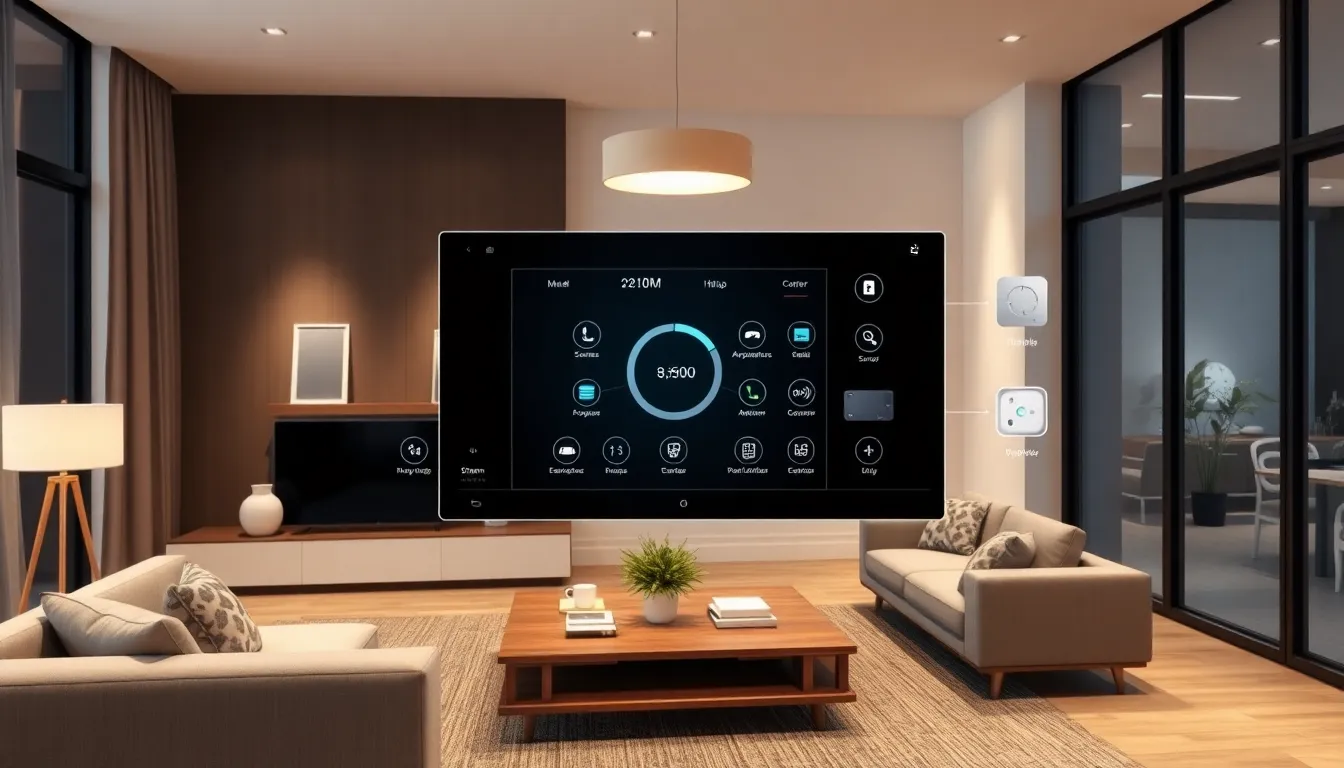Table of Contents
ToggleImagine walking into your home and having it greet you like an old friend. Lights flicker on, the thermostat adjusts to your favorite temperature, and your favorite playlist starts playing—all without lifting a finger. Welcome to the world of home automation system design, where technology meets convenience in a way that even your most demanding houseplant would approve.
Home automation isn’t just a luxury; it’s a lifestyle upgrade that makes everyday living more efficient and enjoyable. From smart thermostats that learn your habits to security systems that keep your castle safe, the possibilities are endless. So why not turn your home into a smart haven? With a sprinkle of creativity and a dash of tech-savvy, anyone can transform their living space into a futuristic retreat that even the Jetsons would envy.
Overview of Home Automation System Design
Home automation system design involves creating a seamless integration of various technologies within a residence. Different components such as lighting, climate control, and security systems work together to enhance convenience and efficiency. The design process focuses on user needs, ensuring that automation features provide real benefits to everyday living.
A well-planned system architecture plays a crucial role in functionality. It typically includes smart devices, a central control hub, and communication protocols. Devices like smart switches allow users to easily manage lighting, while thermostats provide energy-saving capabilities.
User interfaces are essential for interaction. Touchscreen panels and mobile applications let homeowners control systems remotely. Voice-activated assistants offer an intuitive way to manage automation simply by speaking commands.
Security is a major consideration in home automation design. Integrating cameras, motion detectors, and smart locks creates a cohesive security ecosystem. Homeowners can receive instant alerts on their mobile devices, ensuring peace of mind.
Scalability is another vital aspect. As technology advances, homeowners must accommodate additional devices without overhauling existing systems. This flexibility allows users to customize their environment continuously.
Overall, successful home automation system design balances functionality and aesthetics. Smart devices should complement the home’s interior while enhancing usability. Prioritizing ease of use ensures homeowners can make the most of automated features, turning daily tasks into effortless experiences.
Key Components of Home Automation

Home automation relies on various essential components to create a smart living environment. Each plays a significant role in ensuring efficiency, convenience, and security.
Sensors and Actuators
Sensors detect changes in the environment, such as temperature, motion, and light levels. For example, motion sensors activate lights when someone enters a room. Similarly, temperature sensors adjust heating or cooling systems based on set preferences. Actuators respond to signals from the sensors, executing actions like opening blinds or locking doors. Together, sensors and actuators create a dynamic system that responds instantly to a homeowner’s needs.
Controllers and Hubs
Controllers manage the communication between devices within a home automation system. Central hubs act as the brain of the system, coordinating data and commands. For instance, a smart home hub connects lighting, security cameras, and thermostats, allowing for seamless integration. These hubs often work with multiple communication protocols, ensuring compatibility across various devices. Choosing the right controller enhances the functionality of the entire system, providing streamlined operation.
User Interfaces
User interfaces serve as the bridge between homeowners and their automation system. Touchscreen panels and mobile apps offer intuitive ways to control different devices. Customizable options allow users to set schedules or monitor home activities remotely. Voice control systems also play a significant role, enabling hands-free operation. The effectiveness of user interfaces significantly affects overall user experience, making it essential to choose interfaces that align with individual preferences.
Design Considerations
Designing a home automation system involves several key aspects that shape its effectiveness and usability. Scalability, security, and energy efficiency rank high on the list of priorities.
Scalability and Flexibility
Scalability ensures that the home automation system adapts to changing needs over time. Homeowners appreciate systems that allow easy addition of new devices without complex redesigns. Flexibility in technology selection provides choices that match user preferences. Future upgrades remain essential—integrating advanced devices enhances functionality while maintaining compatibility with existing components. Investing in a scalable design protects against obsolescence.
Security and Privacy
Security stands as a critical consideration in home automation. Users expect robust protection against unauthorized access to their systems. Strong encryption methods and secure communication protocols form the foundation of effective security measures. Privacy concerns also rise; systems should allow user control over data sharing. Regular software updates help mitigate vulnerabilities and keep systems secure. Furthermore, visual alerts or notifications provide homeowners with real-time information about their automated environment.
Energy Efficiency
Energy efficiency plays a vital role in home automation design. Smart devices such as programmable thermostats and energy-efficient lighting significantly lower energy consumption. Incorporating sensors that adjust settings based on occupancy enhances efficiency further. Homeowners can monitor energy usage through user-friendly interfaces, allowing informed decisions about their consumption. Lower energy bills not only contribute to savings but also promote environmentally friendly practices. Prioritizing energy efficiency creates sustainable and cost-effective living spaces.
Popular Home Automation Technologies
Home automation relies on various technologies for effective communication and device control. Understanding these technologies helps homeowners choose the best solutions for their needs.
Wi-Fi and Zigbee
Wi-Fi plays a significant role in home automation, providing robust connectivity for devices such as smart speakers and cameras. Zigbee, on the other hand, excels in creating mesh networks, allowing devices to communicate efficiently even over longer distances. Zigbee devices consume less power, making them ideal for battery-operated gadgets like sensors and remote controls. Integration of both technologies can enhance performance, offering flexibility in device placement while ensuring consistent communication. Many smart hubs support both Wi-Fi and Zigbee, simplifying the management of a diverse range of devices.
Bluetooth and Z-Wave
Bluetooth facilitates immediate connections between devices, often used for short-range applications, like smart locks and wearable tech. Z-Wave, however, focuses on home automation, operating on a low-frequency band to minimize interference from Wi-Fi networks. This technology supports a wide array of devices, creating reliable communication for smart lights, thermostats, and security systems. Z-Wave’s mesh networking capabilities strengthen signals throughout the home. Mixing Bluetooth and Z-Wave devices provides homeowners with more options for automation, allowing for seamless integration across various functionalities.
Home automation system design offers a transformative approach to modern living. By integrating smart technology into everyday life homeowners can enjoy increased convenience and efficiency. Prioritizing user needs security and scalability ensures that these systems not only enhance functionality but also adapt to evolving lifestyles.
Embracing the latest technologies allows for a seamless blend of innovation and aesthetics creating spaces that are both smart and visually appealing. As homeowners explore their options they’ll find that the possibilities for customization and improvement are virtually limitless. Investing in a well-designed home automation system can lead to a more comfortable and secure living environment tailored to individual preferences.




